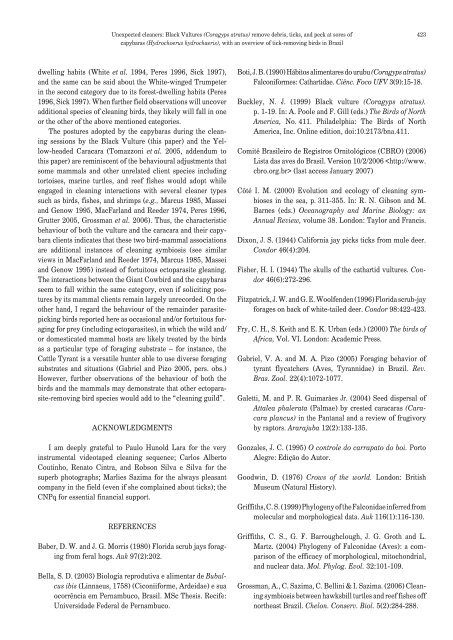You also want an ePaper? Increase the reach of your titles
YUMPU automatically turns print PDFs into web optimized ePapers that Google loves.
Unexpected cleaners: Black Vultures (Coragyps atratus) remove debris, ticks, and peck at sores of<br />
capybaras (Hydrochoerus hydrochaeris), with an overview of tick‑removing birds in Brazil<br />
dwelling habits (White et al. 1994, Peres 1996, Sick 1997),<br />
and the same can be said about the White‑winged Trumpeter<br />
in the second category due to its forest‑dwelling habits (Peres<br />
1996, Sick 1997). When further field observations will uncover<br />
additional species of cleaning birds, they likely will fall in one<br />
or the other of the above mentioned categories.<br />
The postures adopted by the capybaras during the clean‑<br />
ing sessions by the Black Vulture (this paper) and the Yel‑<br />
low‑headed Caracara (Tomazzoni et al. 2005, addendum to<br />
this paper) are reminiscent of the behavioural adjustments that<br />
some mammals and other unrelated client species including<br />
tortoises, marine turtles, and reef fishes would adopt while<br />
engaged in cleaning interactions with several cleaner types<br />
such as birds, fishes, and shrimps (e.g., Marcus 1985, Massei<br />
and Genow 1995, MacFarland and Reeder 1974, Peres 1996,<br />
Grutter 2005, Grossman et al. 2006). Thus, the characteristic<br />
behaviour of both the vulture and the caracara and their capy‑<br />
bara clients indicates that these two bird‑mammal associations<br />
are additional instances of cleaning symbiosis (see similar<br />
views in MacFarland and Reeder 1974, Marcus 1985, Massei<br />
and Genow 1995) instead of fortuitous ectoparasite gleaning.<br />
The interactions between the Giant Cowbird and the capybaras<br />
seem to fall within the same category, even if soliciting pos‑<br />
tures by its mammal clients remain largely unrecorded. On the<br />
other hand, I regard the behaviour of the remainder parasite‑<br />
picking birds reported here as occasional and/or fortuitous for‑<br />
aging for prey (including ectoparasites), in which the wild and/<br />
or domesticated mammal hosts are likely treated by the birds<br />
as a particular type of foraging substrate – for instance, the<br />
Cattle Tyrant is a versatile hunter able to use diverse foraging<br />
substrates and situations (Gabriel and Pizo 2005, pers. obs.)<br />
However, further observations of the behaviour of both the<br />
birds and the mammals may demonstrate that other ectopara‑<br />
site‑removing bird species would add to the “cleaning guild”.<br />
ACKNOWLEDGMENTS<br />
I am deeply grateful to Paulo Hunold Lara for the very<br />
instrumental videotaped cleaning sequence; Carlos Alberto<br />
Coutinho, Renato Cintra, and Robson Silva e Silva for the<br />
superb photographs; Marlies Sazima for the always pleasant<br />
company in the field (even if she complained about ticks); the<br />
CNPq for essential financial support.<br />
REFERENCES<br />
Baber, D. W. and J. G. Morris (1980) Flori<strong>da</strong> scrub jays forag‑<br />
ing from feral hogs. Auk 97(2):202.<br />
Bella, S. D. (2003) Biologia reprodutiva e alimentar de Bubulcus<br />
ibis (Linnaeus, 1758) (Ciconiiforme, Ardei<strong>da</strong>e) e sua<br />
ocorrência em Pernambuco, Brasil. MSc Thesis. Recife:<br />
Universi<strong>da</strong>de Federal de Pernambuco.<br />
423<br />
Boti, J. B. (1990) Hábitos alimentares do urubu (Coragyps atratus)<br />
Falconiformes: Catharti<strong>da</strong>e. Ciênc. Foco UFV 3(9):15‑18.<br />
Buckley, N. J. (1999) Black vulture (Coragyps atratus).<br />
p. 1‑19. In: A. Poole and F. Gill (eds.) The Birds of North<br />
America, No. 411. Philadelphia: The Birds of North<br />
America, Inc. Online edition, doi:10.2173/bna.411.<br />
Comitê Brasileiro de Registros Ornitológicos (CBRO) (2006)<br />
Lista <strong>da</strong>s aves do Brasil. Version 10/2/2006 (last access January 2007)<br />
Côté I. M. (2000) Evolution and ecology of cleaning sym‑<br />
bioses in the sea, p. 311‑355. In: R. N. Gibson and M.<br />
Barnes (eds.) Oceanography and Marine Biology: an<br />
Annual Review, volume 38. London: Taylor and Francis.<br />
Dixon, J. S. (1944) California jay picks ticks from mule deer.<br />
Condor 46(4):204.<br />
Fisher, H. I. (1944) The skulls of the cathartid vultures. Condor<br />
46(6):272‑296.<br />
Fitzpatrick, J. W. and G. E. Woolfenden (1996) Flori<strong>da</strong> scrub‑jay<br />
forages on back of white‑tailed deer. Condor 98:422‑423.<br />
Fry, C. H., S. Keith and E. K. Urban (eds.) (2000) The birds of<br />
Africa, Vol. VI. London: Academic Press.<br />
Gabriel, V. A. and M. A. Pizo (2005) Foraging behavior of<br />
tyrant flycatchers (Aves, Tyranni<strong>da</strong>e) in Brazil. Rev.<br />
Bras. Zool. 22(4):1072‑1077.<br />
Galetti, M. and P. R. Guimarães Jr. (2004) Seed dispersal of<br />
Attalea phalerata (Palmae) by crested caracaras (Caracara<br />
plancus) in the Pantanal and a review of frugivory<br />
by raptors. Ararajuba 12(2):133‑135.<br />
Gonzales, J. C. (1995) O controle do carrapato do boi. Porto<br />
Alegre: Edição do Autor.<br />
Goodwin, D. (1976) Crows of the world. London: British<br />
Museum (Natural History).<br />
Griffiths, C. S. (1999) Phylogeny of the Falconi<strong>da</strong>e inferred from<br />
molecular and morphological <strong>da</strong>ta. Auk 116(1):116‑130.<br />
Griffiths, C. S., G. F. Barroughclough, J. G. Groth and L.<br />
Martz. (2004) Phylogeny of Falconi<strong>da</strong>e (Aves): a com‑<br />
parison of the efficacy of morphological, mitochondrial,<br />
and nuclear <strong>da</strong>ta. Mol. Phylog. Evol. 32:101‑109.<br />
Grossman, A., C. Sazima, C. Bellini & I. Sazima. (2006) Clean‑<br />
ing symbiosis between hawksbill turtles and reef fishes off<br />
northeast Brazil. Chelon. Conserv. Biol. 5(2):284‑288.

















